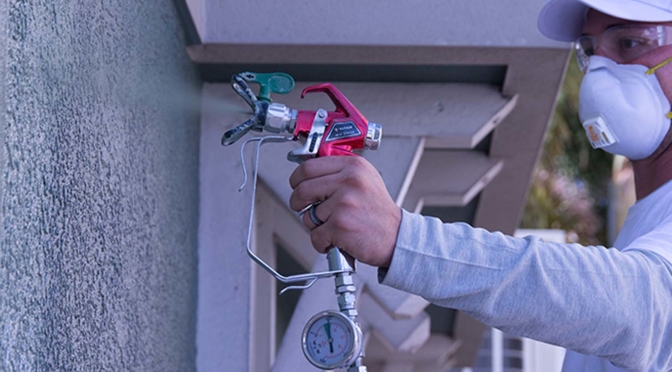Before you buy, consider these five factors.
It’s easy to get overwhelmed by the sheer number of options when selecting an airless spray gun. For many painters, the decision is especially important because the spray gun is what they’ll be holding in their hand for the vast majority of the workday.
“I was a sales rep for nine years,” says Chris Noto, Director of Professional Products at Titan. “In my experience, it was easier to convince a painter to switch paint sprayers than to switch guns. When something’s in your hand for eight hours a day, you get used to it. You get comfortable with it. That’s why it’s worth getting all the little details right and finding a gun you’re really happy with.”
In this article, Noto explains the most important factors you should consider when purchasing a new spray gun.
Pressure
You should first consider whether your paint sprayer is standard-pressure (roughly 3000 to 3300 PSI) or high-pressure (roughly 5000 to 7000 PSI).
A high-pressure sprayer will require a stainless-steel spray gun that can handle those higher pressures, while a standard aluminum gun will be sufficient for a standard-pressure sprayer. If you’re working with specialty coatings like high solids coatings, water proofing coatings or mastics, you should also think about upgrading to a stainless-steel gun, because stainless steel guns are more durable.
Filtration
When buying a spray gun, you need to decide whether you want to buy a gun with a filter or without one. Among guns with filters, they can come in different configurations. Some have filters built into the handle, while others have a front-feed configuration.
To decide between these options, you should consider whether the coating you’re using should be filtered or not. Some coatings can’t be filtered because they plug up too quickly, resulting in a loss of momentum and pressure. If you’re working with a coating like that, make sure your gun doesn’t have a filter.
For example, for disproportionately thick materials, such as drywall compound, Noto recommends a front-feed gun with no filter. He says, “Because the front-feed flows directly to the front of the gun, it helps the compound flow through and spray better.”
Special Functions
If you’re working at high angles, such as in houses with multi-story foyers, you may want a more specialized tool for the job. Inline guns (sometimes known as “pole guns”) like the LX-75 Inline Gun can be attached to extensions, poles, and rollers, allowing you to create the perfect finish even in awkward angles and hard-to-reach spaces.
Those working with thick coatings may also want an extra-large barrel that allows for a wider fluid passage. Noto recommends the M-8 Airless Spray Gun, which boasts a 3/8” barrel (versus 1/4″ on most other guns) and can handle pressures up to 7700 PSI.
Repair Kit
Even the best tools have to be replaced eventually. When buying, it’s good to consider both how long the gun is expected to last and what repair options—if any—will be available after the gun wears out.
“Guns are good for a certain amount of trigger pulls or gallons, depending on how the manufacturer defines it,” Noto says. “When a gun wears out, the contractor has to decide, ‘Do I throw away the gun or do I rebuild the gun using a repair kit?’”
Repair kits usually cost less than the cost of buying a new gun, though prices vary by model and manufacturer, and of course repairing requires more work on the part of the contractor. Repairs will usually be needed on three major parts: the diffuser, the seat, and the spring assembly. Some manufacturers may simplify the repair process or offer perks, especially with premium gun models. Titan, for instance, offers Infinity Packing® for their RX-PRO® and RX-APEX™ guns, which feature reversible packing and inexpensive repair kits.
Comfort
Having considered most of the functional and practical factors, the last one to consider is more subjective and personal: Is the spray gun comfortable to hold? The answer to this question will vary from contractor to contractor. While other spray guns offer additional features or variables beyond the ones discussed in this article, most of them primarily affect the “feel” of the gun more than the final product. As such, finding the best gun for you will be a subjective process.
Variables to consider should include:
- Gun angle
- Gun weight
- Standard-sized versus compact guns
- Two-finger versus four-finger trigger
- Trigger pressure and sensitivity
- Potential for ergonomic adjustments
To try out different models and find out what you prefer, visit your local Sherwin-Williams or a product expo. After all, you’re the one who’s going to be holding it for hours on end—it’s worth it to find the perfect ergonomics for you.
Conclusion
Purchasing an airless spray gun can be intimidating at first because of all the options, but keeping these five factors in mind should simplify the process. Consider the needs of your job and your coating, keep an eye on the product’s longevity, and find a gun that’s comfortable to hold.

